Emily Lakdawalla • Apr 05, 2018
Preview of the InSight Mars launch
NASA’s next planetary launch is coming up soon. InSight, a mission focused on Mars geophysics, launches atop an Atlas V from Vandenberg Air Force Base during a launch period that opens on May 5, 2018. This post is your one-stop shop for information about InSight’s launch, cruise, and expected mission to Mars. It is based largely on NASA’s as-ever-excellent press kit (PDF, 7MB).
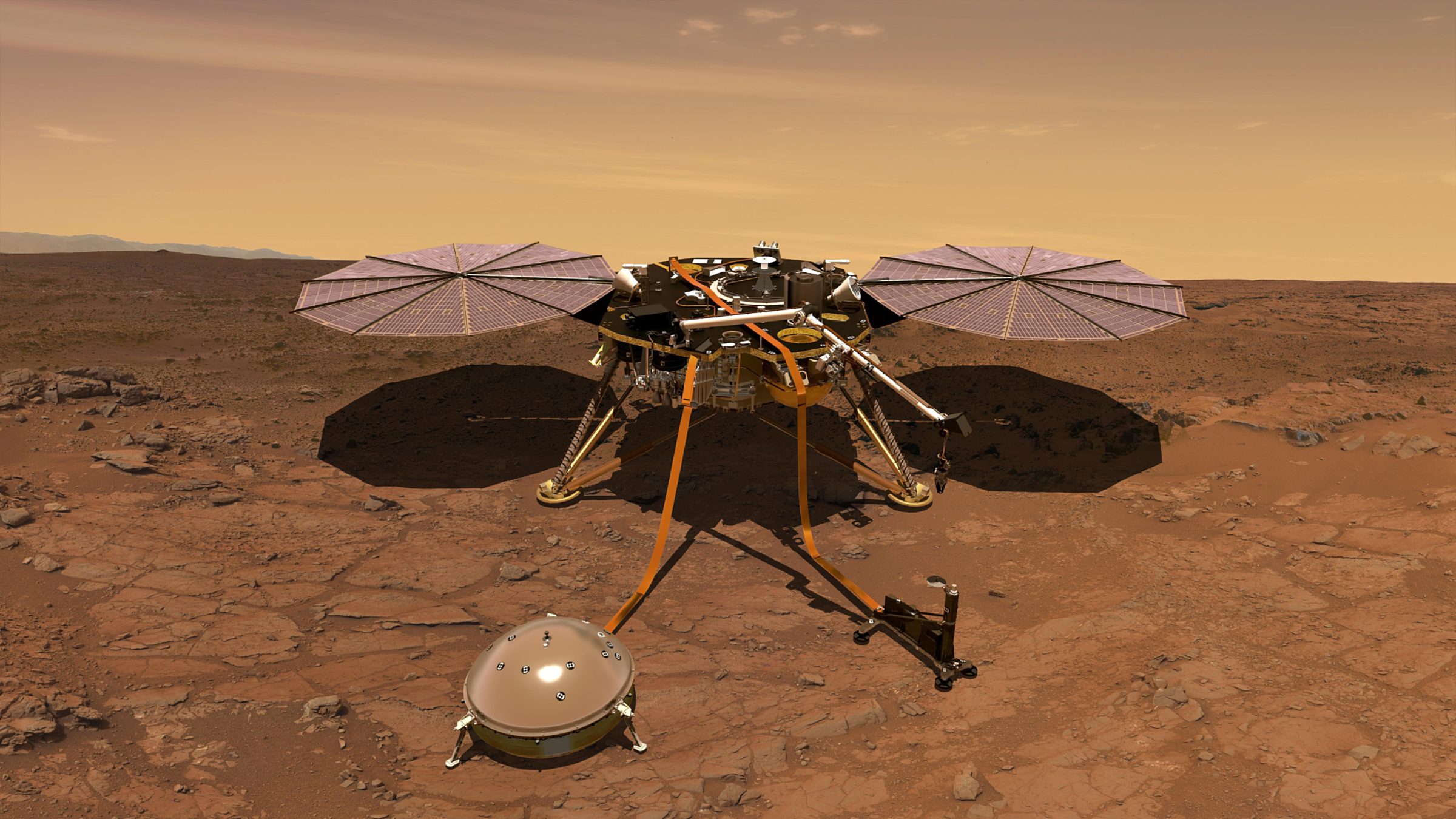
Mission Overview
InSight is a lander, and a small one, weighing in at 358 kilograms. (This is about the same weight as Spirit and Opportunity together, but only a third the weight of Curiosity.) It's based on the design of the Phoenix Mars lander, but the solar panels are larger and structurally stronger. The deck is about a meter off the ground and is about 1.5 meters wide. Its solar arrays span 6 meters. The solar arrays can generate up to 700 watts on a clear day with little accumulated dust.
InSight carries two science instruments: a very sensitive seismometer and a heat probe. They'll both be placed on the surface using a robotic arm. There are two cameras, a meteorology package, and a radio science experiment. Here's a video overview:
The mission stands to achieve many firsts. It'll be the first interplanetary launch from the U.S.'s west coast. It'll deploy the first seismometer on Mars that'll actually touch the ground, the deepest heat probe, and the first magnetometer ever at the surface. It will be accompanied to Mars by the first two deep-space CubeSats in the MarCO experimental mission. I'll describe MarCO in more detail in a separate post.
“InSight” technically stands for “(Interior Exploration using Seismic Investigations, Geodesy and Heat Transport”, but that is probably the last time you’ll ever see that explanation on this website. “InSight” is a perfectly good name for a mission whose goal is to study the deep interior of a planet without it being a tortured backronym. (I’m looking at you, MESSENGER.)
Launch Plans and Timeline
The launch period lasts from May 5 to June 8, 2018. The launch window lasts two hours each day. On May 5, the window opens at 4:05 a.m. local time (7:05 EDT and 11:05 UTC). There are launch opportunities every five minutes within each window. If the launch is delayed by a day, it slips earlier by a few minutes the next day. The launch window on June 8 opens at 1:30 PDT / 4:30 EDT / 8:30 UTC. The launch should be visible from much of coastal southern California, in theory, though low clouds or fog are common conditions in the early morning in the spring here.
Following is a table of expected launch event times for a launch at the beginning of the first launch window. I'll update this and repost it if there's a change in the launch date and time. It was last updated on April 5.
| Event | Elapsed time (s) | Time (PDT) | Time (EDT) | Time (UTC) | Time (CEST) |
|---|---|---|---|---|---|
| Mission overview press briefing (JPL) | Mar 29 14:00 | Mar 29 17:00 | Mar 29 21:00 | Mar 29 23:00 | |
| Prelaunch press briefing (VAFB) | May 3 13:00 | May 3 16:00 | May 3 20:00 | May 3 22:00 | |
| Live launch feed begins | May 5 03:30 | May 5 06:30 | May 5 10:30 | May 5 12:30 | |
| Ignition | -3.8 | 04:04 | 07:04 | 11:04 | 13:04 |
| T-zero | 0.0 | 04:05 | 07:05 | 11:05 | 13:05 |
| Liftoff | 1.1 | 04:05 | 07:05 | 11:05 | 13:05 |
| Booster engine cutoff (BECO) | 244.3 | 04:09 | 07:09 | 11:09 | 13:09 |
| First stage jettison | 250.3 | 04:09 | 07:09 | 11:09 | 13:09 |
| Centaur main engine start 1 (MES1) | 260.3 | 04:09 | 07:09 | 11:09 | 13:09 |
| Payload fairing jettison | 268.3 | 04:09 | 07:09 | 11:09 | 13:09 |
| Centaur main engine cutoff 1 (MECO1) | 796.2 | 04:18 | 07:18 | 11:18 | 13:18 |
| Centaur main engine start 2 (MES2) | 4736.9 | 05:23 | 08:23 | 12:23 | 14:23 |
| Centaur main engine cutoff 2 (MECO2) | 5059.8 | 05:29 | 08:29 | 12:29 | 14:29 |
| InSight separation and earliest AOS | 5599.8 | 05:38 | 08:38 | 12:38 | 14:38 |
| MarCO-A separation | 5633.8 | 05:38 | 08:38 | 12:38 | 14:38 |
| MarCO-B separation | 5681.8 | 05:39 | 08:39 | 12:39 | 14:39 |
| Latest expected InSight AOS | 6439.8 | 05:52 | 08:52 | 12:52 | 14:52 |
| Latest expected MarCO AOS | 8333.8 | 06:23 | 09:23 | 13:23 | 15:23 |
| Event | Elapsed time (s) | Time (PDT) | Time (EDT) | Time (UTC) | Time (CEST) |
It'll be the first planetary launch from Vandenberg. InSight is a very small spacecraft and the Atlas V has power to spare. To relieve congestion out of Florida and because they could, NASA planned a launch from Vandenberg.
The main difference between Vandenberg and Kennedy launches is that Kennedy launches to the east and Vandenberg launches to the south. Typically, Kennedy launches produce orbits closer to the equator and Vandenberg produces polar orbits. In most planetary launches, the rocket delivers the spacecraft into Earth orbit, then there's a short coast phase, and then the upper stage restarts to take the spacecraft out of Earth orbit and onto cruise. Kennedy's eastward launches take advantage of Earth's rotation to help throw payloads into orbit, so if you're pushing the limits of your rocket, it's nice to have that help. But once your spacecraft is in any Earth orbit, it takes the same amount of thrust to move from that Earth orbit to a Mars transfer orbit regardless of the orbit inclination. (For a little more info, read this tweet thread by Mark Wallace, who designed the trajectory.)
The launch vehicle is an Atlas V 401. InSight's will be the 62nd launch of the Atlas V. "401" signifies that the payload fairing is the smaller option (4 meters in diameter); there are no extra strap-on boosters attached to the common-core booster; and the Centaur upper stage has a single engine. The MarCO satellites ride inside an aft bulkhead carrier, at the bottom end of the Centaur.
InSight will separate from the launch vehicle within 90 minutes of launch. Its cruise stage solar arrays are already fully deployed at launch. After separation, it will determine its orientation in space and then turn to the correct attitude for communication with Earth. The Deep Space Network radio antennas at Goldstone should be the first to pick up its signal, some time between 0 and 14 minutes after spacecraft separation.
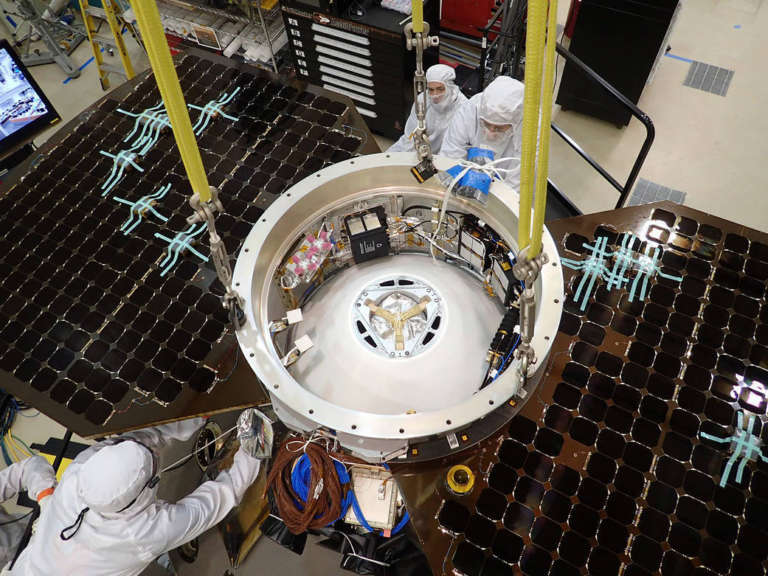
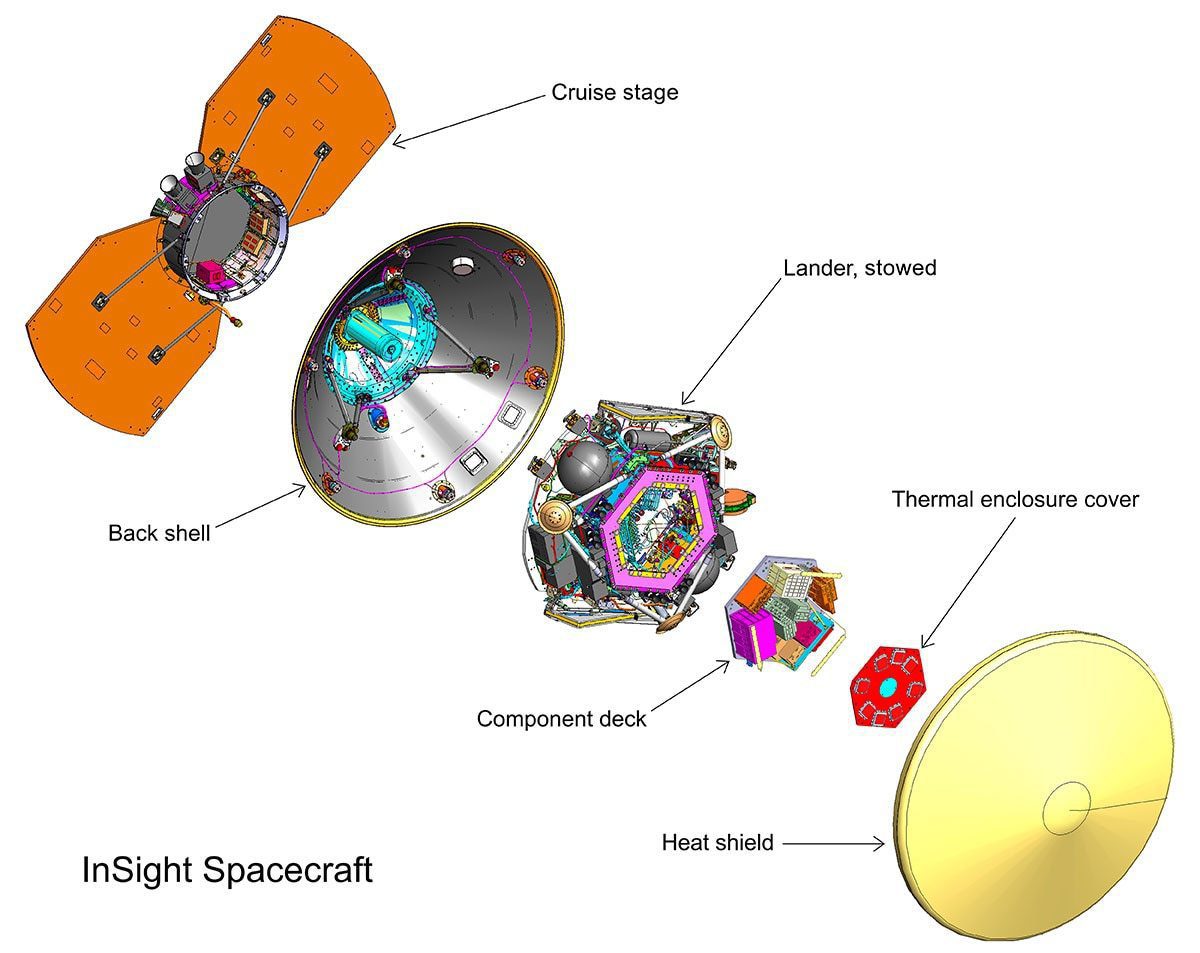
Cruise and Landing
The cruise stage is a squat cylinder about a meter across, with two fixed solar panels extending out to 3.4 meters. It has antennas, a radio transponder, electronics for the solar panels, two Sun sensors, and two star trackers. It has no thrusters and no computer; cruise thrusters are located on the spacecraft's backshell, and the cruise stage is operated by the lander's electronic brain. The cruise stage will be jettisoned just before landing.
The backshell has four trajectory correction maneuver thrusters, each 22 newtons, for coarse course adjustment. It also has four reaction control system thrusters, each 4.4 newtons, for fine steering. The lander has 12 descent engines of 302 newtons each.
Here is a summary of the expected cruise events and a trajectory diagram. Depending on performance, the mission may choose not to perform one or more of these maneuvers.

| Event | Date (UTC) |
|---|---|
| Trajectory correction maneuver (TCM) 1 | 15 May 2018 |
| TCM 2 | 28 Jul 2018 |
| Approach phase begins | 27 Sep 2018 |
| TCM 3 | 12 Oct 2018 |
| TCM 4 | 11 Nov 2018 |
| TCM 5 | 18 Nov 2018 |
| TCM 5 (backup opportunity) | 21 Nov 2018 |
| TCM 6 | 25 Nov 2018 |
| TCM 6 (backup opportunity) | 26 Nov 2018 |
| Landing day | 26 Nov 2018 |
| Instrument placement complete | 4 Feb 2019 |
| Heat probe placement complete | 25 Mar 2019 |
Regardless of the launch date, the landing date is November 26, 2018, at about noon PST (15:00 EDT / 20:00 UTC). The landing site is at 4.5N/135.9E, in Elysium Planitia. I'll post a lengthy landing explainer in September or October.
When it lands, the spacecraft will face south, with solar panels spread to the east and west, so that the workspace will be in sunlight all day long. The prime mission is planned to last two Earth years (one Mars year plus 40 sols). It will take as many as 10 weeks to place the instruments on the ground and gather context data, and as many as 7 more weeks for the heat probe to burrow its way to its maximum depth.
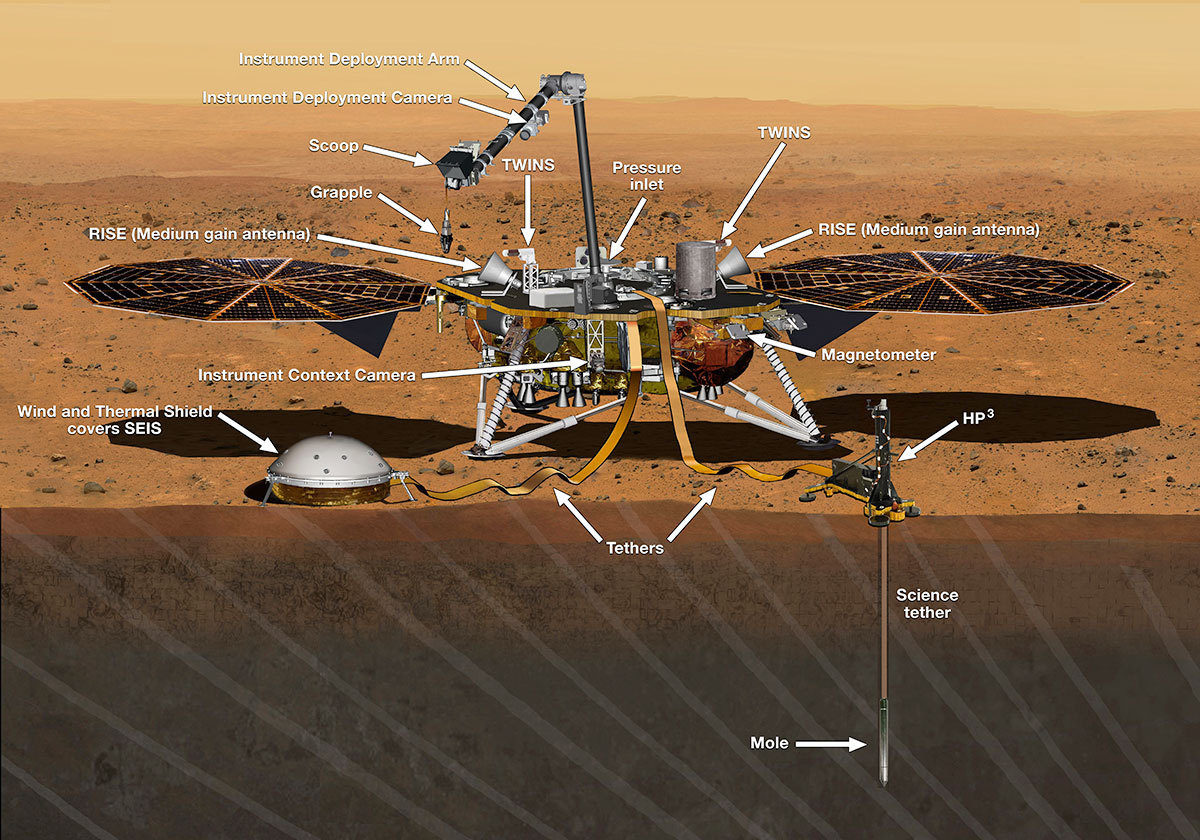
Equipment and Instruments
Radio science & communication
InSight carries a helical UHF antenna for data relay to orbiters. It has two medium-gain X-band horn antennas for communication with Earth, one pointed up and east and one pointed up and west. None of the antennas is steerable. The X-band antennas allow InSight to receive commands from Earth. The Rotation and Interior Structure Experiment (RISE) will use the X-band link with Earth to sensitively measure perturbations of Mars' rotation axis over the course of a Mars year, yielding information about the size of the core and how much of it is molten.
Electronics and software
InSight's avionics have heritage from MAVEN and GRAIL. There are two main computers for redundancy. Each has a RAD 750 processor operating at 115.5 megahertz, with 64 gigabits of flash memory. The flight software is written in C and C++ within the VxWorks operating system. Individual instruments have their own electronics and flight software, but they send data to the main computer for staging and relay to Earth.
Robotic arm and engineering cameras
The Instrument Deployment System (IDS) consists of arm and cameras. The Instrument Deployment Arm (IDA) describes the arm alone. It is 2.4 meters long and has four degrees of freedom (two at the shoulder and one each at wrist and elbow). It was built for the canceled 2001 Surveyor lander (the rest of Surveyor lander was refurbished into the Phoenix lander, which needed a different arm for digging).
The two cameras are modified versions of a Navcam and a Hazcam like those used on Opportunity and Curiosity. The arm camera, also called the Instrument Deployment Camera (IDC), is mounted to the forearm, between elbow and wrist. Its field of view is 45 degrees, like rover Navcams. The deck camera, called the Instrument Context Camera (ICC), is mounted underneath the front edge of the lander deck. Its field of view is a wide, fish-eye 120 degrees, like rover Hazcams.
Unlike Navcams and Hazcams, the InSight cameras have Bayer filters on their detectors, so they produce color photos. They are single cameras so can't take simultaneous stereo pairs, but the arm can shift the arm camera's point of view to obtain sequential stereo pairs. The arm will also use its camera to take 360-degree panoramas around the lander, just as rover Navcams do, and can do that from two slightly different points of view to get a stereo panorama.
At the tip of the arm is a grapple with five mechanical fingers, shaped to grasp specially designed, ball-shaped handles on top of the devices that it will deploy. Here's a video showing the arm at work:
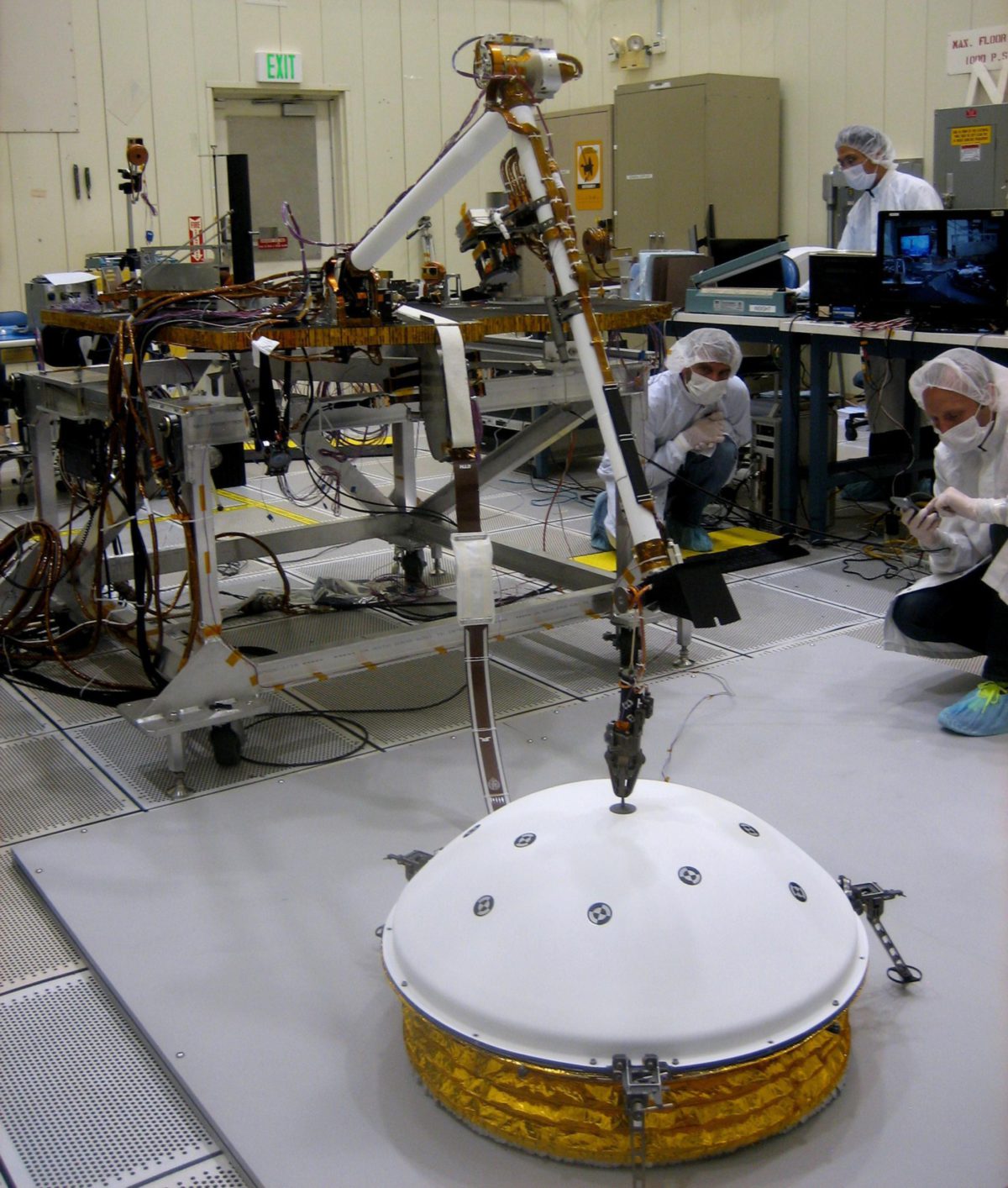
Seismic Experiment for Interior Structure (SEIS)
SEIS includes six sensors to measure ground motions. Three measure long-period motions and three measure short-period motions. The sensors are mounted to a precision leveling structure that will rest on the ground on three legs. It has a long, flexible tether that connects it to the lander's electronics. The arm will grasp SEIS and set it on the ground.
A separate Wind and Thermal Shield will protect SEIS after its deployment. The arm will place the shield over the seismometer. The shield has a chain-mail skirt to accommodate an uneven ground surface.
Heat Flow and Physical Properties Probe (HP3)
HP3 (pronounced "H-P-cubed") is a self-hammering mechanical mole that will begin at the surface (placed there by the arm) and then burrow as much as 5 meters down into the surface during a period of 30 to 40 days. The mole is 2.7 centimeters wide and 40 centimeters long. It contains sensors and heaters that it will use to measure how readily the Martian ground conducts heat.
It has a long tether including 14 temperature sensors that will maintain its connection to a support structure that will remain on the surface. An engineering tether connects the support structure to the lander electronics. It has half a gigabyte of memory, enough to store the entire load of data expected to be produced during the nominal mission. There is also a radiometer mounted to the lander that will separately measure ground-surface temperature using infrared brightness.
Auxiliary Payload Sensor Subsystem (APSS)
A set of engineering instruments will measure magnetic field, wind, and atmospheric temperature and pressure to support the interpretation of ground-motion data from SEIS. The magnetometer is the first ever sent to the surface of Mars. The wind and air temperature sensors, called Temperature and Wind for InSight (TWINS) are refurbished flight spares of the booms on the Rover Environmental Monitoring Station (REMS) instrument on Curiosity. The pressure sensor is inside the lander and is similar to, but more sensitive than, pressure sensors on Viking and Pathfinder.
While not technically a science instrument, APSS data will clearly be of value to Mars meteorologists, especially the Curiosity REMS team.
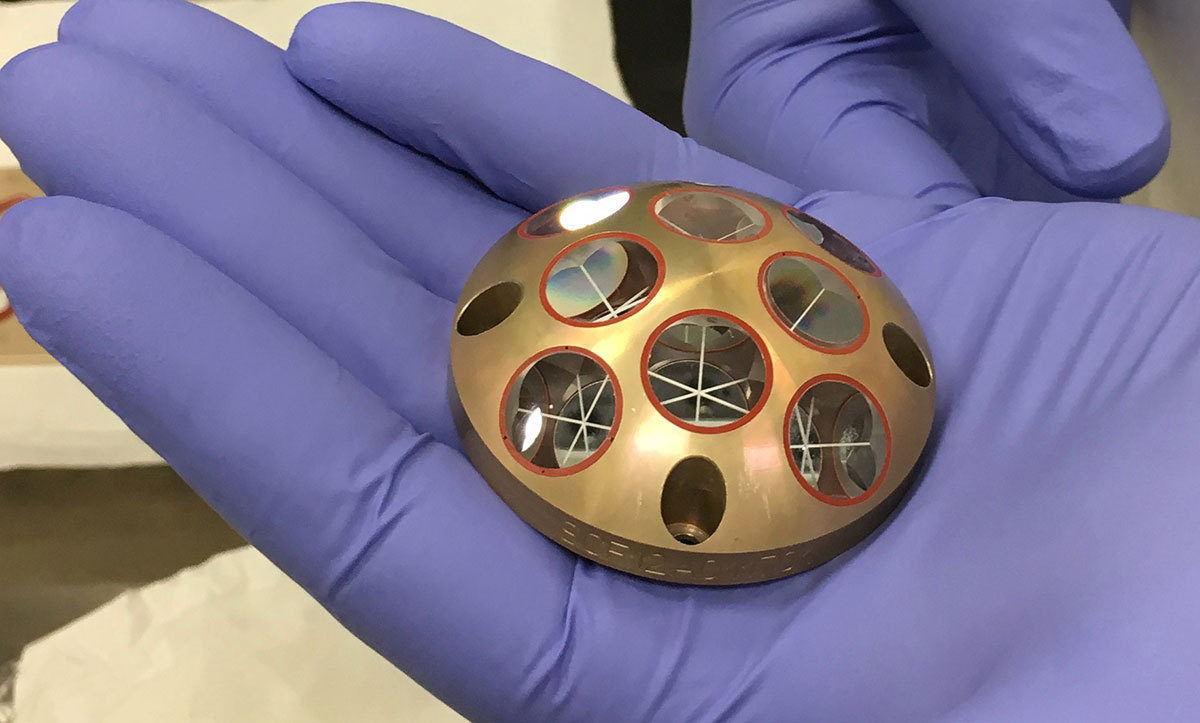
Laser Retroreflector for InSight (LaRRI)
LaRRI won't actually be used as part of the InSight mission, but is included on the lander to benefit future science. It is a set of corner-cube reflectors that could be used with an orbiting laser altimeter for very precise distance estimation.
Science Goals and Mission Success Criteria
There are two science goals:
- Understand the formation and evolution of terrestrial planets through investigation of the interior structure and processes of Mars; and
- Determine the present levels of tectonic activity and meteorite-impact activity on Mars.
To accomplish these goals, there are six science objectives, each of which has a set of quantifiable success criteria (the following copied verbatim from the press kit):
- Determine the thickness and structure of the crust
- Determine the crustal thickness with a precision of plus or minus 10 kilometers (6.2 miles). The pre-InSight state of knowledge is that the crust is about 65 kilometers (40 miles) thick, plus or minus 35 kilometers (22 miles).
- Resolve crustal layers with a thickness of 5 kilometers (3 miles) or greater. Prior to InSight, there is no certain knowledge about crustal layering.
- Determine the composition and structure of the mantle
- Determine the velocities of seismic waves in the upper 600-kilometer (373-mile) of the mantle to a precision of plus or minus 0.25 kilometer per second (560 miles per hour). Mantle composition can be inferred from seismic velocities. The pre-InSight state of knowledge is that velocity of seismic waves through the mantle is about 8 kilometers per second (about 18,000 miles per hour) with an uncertainty of plus or minus 1 kilometer per second (about 2,200 miles per hour).
- Determine the size, composition, and physical state of the core
- Positively distinguish between a liquid and solid outer core.
- Determine the radius of the core to a precision of plus or minus 200 kilometers (124 miles). Current estimates are that the core radius is about 1,700 kilometers (about 1,050 miles) plus or minus 300 kilometers (186 miles).
- Determine the core's density to a precision of plus or minus 450 kilograms per cubic meter (28 pounds per cubic foot). Core composition can be inferred from density. The pre-InSight state of knowledge is that the core density is about 6,400 kilograms per cubic meter (400 pounds per cubic foot) plus or minus 1,000 kilograms per cubic meter (62 pounds per cubic foot).
- Determine the thermal state of the interior
- Determine the heat flux from the planet's interior at the landing site to a precision of plus or minus 5 milliwatts per square meter (one-half milliwatt per square foot). Pre-InSight estimates are that the heat flux from the Martian interior is about 30 milliwatts per square meter (3 milliwatts per square foot) plus or minus 2.5 milliwatts per square meter (2.5 milliwatts per square foot).
- Measure the rate and geographic distribution of seismic activity
- Determine the rate of seismic activity to within a factor of two; determine the distance to the epicenter of a seismic event to within 25 percent; and determine the azimuth (compass direction) to the epicenter to within 20 degrees. None of these values have previously been measured.
- Measure the rate of meteorite impacts on the surface
- Determine the meteorite impact rate on Mars to within a factor of two. Current estimates are within a factor of about six.
Closer to landing, there will be further posts about mission science. Stay tuned!
The Time is Now.
As a Planetary Defender, you’re part of our mission to decrease the risk of Earth being hit by an asteroid or comet.
Donate Today

 Explore Worlds
Explore Worlds Find Life
Find Life Defend Earth
Defend Earth

